- MaxDividends
- Posts
- The Smartest Dividend Stocks in Bill Ackman’s Portfolio to Buy With $1,000 Right Now
The Smartest Dividend Stocks in Bill Ackman’s Portfolio to Buy With $1,000 Right Now
Billionaire investor Bill Ackman has built a high-performing portfolio with a 173% return over five years. Here are two of his top dividend stocks worth buying today for steady income
MaxDividends Mission: Helping & Supporting Everyone in Building a Growing Passive Income, Retiring Early, and Living Off Dividends.
Partnerships & Sponsorships: [email protected]
For dividend investors seeking opportunities with strong growth potential, MaxDividends Stock Ideas offers a daily, in-depth look at companies worth considering for a dividend portfolio.
Scroll Down to Read. No access yet? Check your status & upgrade to Premium to join the movement. Exclusive insights await inside!
Billionaire investor Bill Ackman has built a high-performing portfolio with a 173% return over five years. Here are two of his top dividend stocks worth buying today for steady income
Intro
💡 Invest in companies you believe in - W. Buffett
Dividend stocks can be a powerful way to generate passive income—especially when backed by strong businesses with room to grow.
Bill Ackman, the founder of Pershing Square Capital Management, is one of the most closely watched investors today, thanks to his concentrated, high-conviction stock picks.
His fund has delivered an impressive 173% return over the past five years, making his portfolio a goldmine for investment ideas.
If you have $1,000 to invest, two of Ackman’s dividend stocks stand out as smart buys right now: Restaurant Brands International (NYSE: QSR) and Nike (NYSE: NKE). Both offer attractive yields, sustainable payouts, and compelling turnaround potential. Let’s dive into why these stocks deserve a spot in your portfolio.
1. Restaurant Brands International Inc (TO: QSR)
Restaurant Brands International Inc. (RBI) is a Canadian-American multinational holding company that owns some of the world’s most recognizable quick-service restaurant chains: Burger King, Tim Hortons, Popeyes Louisiana Kitchen, and Firehouse Subs.

RBI was formed in 2014 through a high-profile $12.5 billion merger between Burger King and Canada’s beloved coffee and doughnut chain, Tim Hortons — a deal partially financed by Warren Buffett’s Berkshire Hathaway. Since then, RBI has continued to expand its portfolio: it acquired Popeyes in 2017 for $1.8 billion, and Firehouse Subs in 2021 for $1 billion, strategically diversifying across fast-food categories.
A key strength of RBI is its asset-light franchise model: over 99% of its 32,000+ restaurants in 120 countries are operated by franchisees, which allows the company to maintain high profit margins and scale rapidly. This model has helped make RBI the fifth-largest fast-food operator in the world as of 2024.
RBI’s brands stand out in several ways:
Burger King is the second-largest burger chain globally, after McDonald's.
Tim Hortons dominates the Canadian coffee market with around 80% share.
Popeyes gained viral fame in 2019 with its hit chicken sandwich.
RBI has become attractive to investors thanks to a 3.6% dividend yield and consistent dividend growth since its founding. Still, it faces challenges, such as the need to revive Burger King's U.S. operations via its $700 million "Reclaim the Flame" strategy and to expand Tim Hortons globally.
The company trades under the ticker QSR on both the NYSE and TSX. Its largest shareholder is Brazilian private equity firm 3G Capital, which holds 26% of the voting power. Under CEO Josh Kobza (formerly the CFO), RBI is targeting 40,000 restaurants worldwide by 2028 as it continues its aggressive growth strategy.
History of the Company
Restaurant Brands International Inc. (RBI) was established in December 2014 through a landmark $12.5 billion merger between Burger King and Tim Hortons, creating one of the world’s largest quick-service restaurant (QSR) conglomerates. The deal was partially financed by Warren Buffett’s Berkshire Hathaway and structured as a tax inversion, which moved Burger King’s legal headquarters to Canada to benefit from lower corporate tax rates—while operations in the U.S. remained unaffected.
The primary goal of the merger was to help Tim Hortons expand globally by leveraging Burger King’s established international franchise network.
RBI’s growth continued in 2017, when it acquired Popeyes Louisiana Kitchen for $1.8 billion, adding a strong, chicken-focused brand to its portfolio. In 2021, RBI further diversified by acquiring Firehouse Subs for $1 billion, entering the fast-casual sandwich segment.
As of today, RBI operates over 32,000 restaurants in more than 120 countries, making it the fifth-largest QSR operator globally—trailing only Subway, McDonald’s, Starbucks, and Yum! Brands.
A Dividend Powerhouse With Staying Power
Since its formation in 2014, Restaurant Brands International (RBI) has established itself as a reliable dividend payer, rewarding shareholders with consistent growth in payouts. The company initiated its dividend program shortly after the Burger King-Tim Hortons merger and has increased its dividend every year, showcasing its commitment to returning capital to investors.
With a current yield of around 3.6%, RBI stands out in the fast-food sector for its balance of income and growth potential. The dividend is well-covered by earnings, with a payout ratio of approximately 75%, leaving room for further increases as the company expands.
RBI’s franchise-heavy business model generates strong, predictable cash flows - key to sustaining and growing dividends long-term. For income-focused investors, RBI represents a rare combination of dividend stability, global scale, and brand power, making it a true Dividend Eagle in the QSR industry.
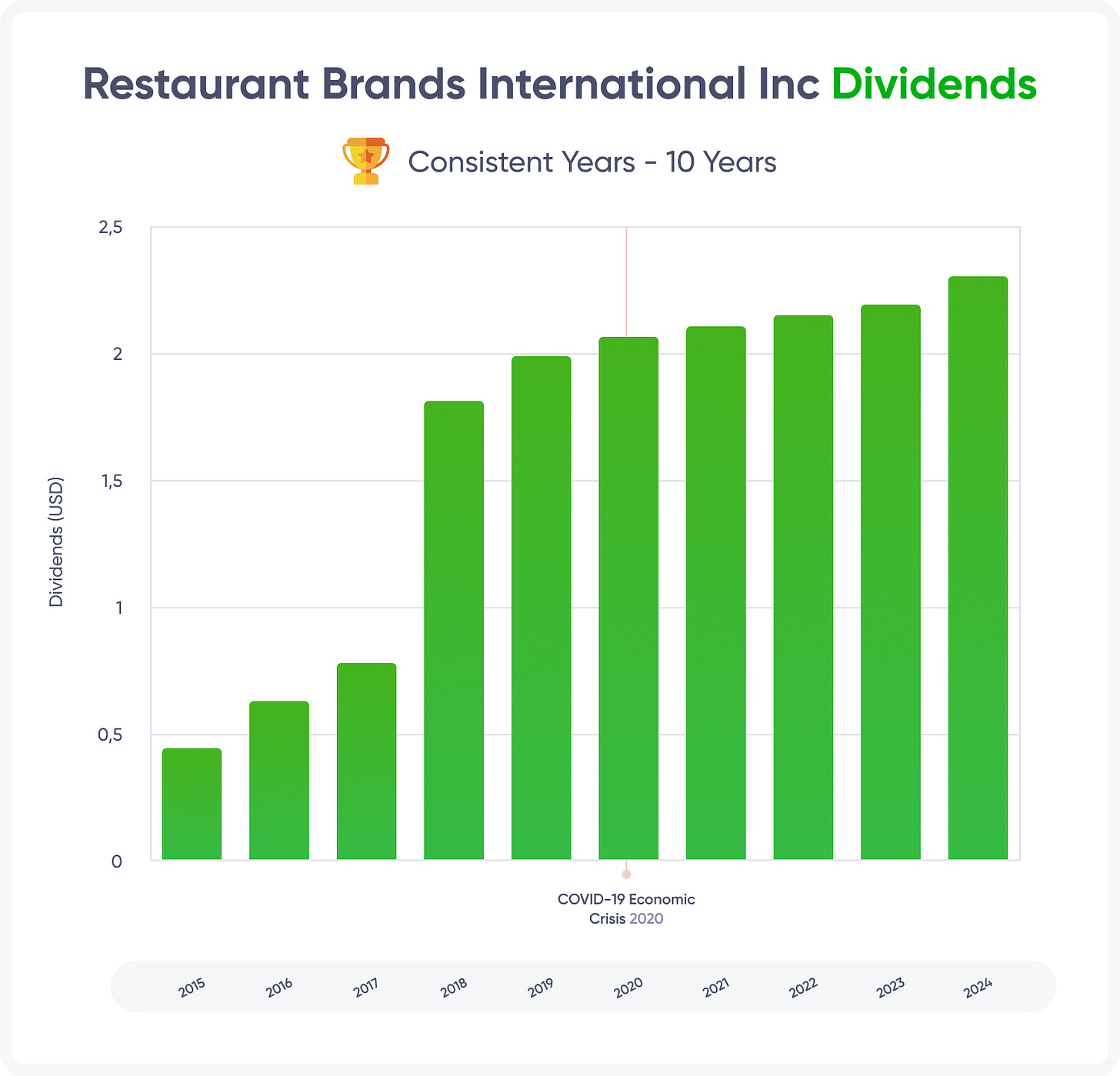
Financial Statement
If you want to stay on top of your portfolio's health, don't forget to check in on the financials of the companies you've invested in. The better shape they’re in, the better your results will be. Keep an eye on their quarterly and annual reports to see how they're performing.
Here is a quick dive into Restaurant Brands International over 3 last years

MaxDividends App: Restaurant Brands International Financial Statement. Revenue.
The strongest and most stable companies tend to have a Financial Score of 80+, with the very best ones hitting 90+. If you see that score start to dip below 80, that’s your cue to consider jumping ship before things get worse.

MaxDividends App List of Top Dividend Stocks
Our Paid Members get access to a curated watchlist of 19,000 companies worldwide, all scored by our team on a regular basis. Companies like Restaurant Brands International are on that list, too.
Future Growth Prospects for Restaurant Brands International
Restaurant Brands International (RBI) is well-positioned for long-term growth, fueled by strategic global expansion, digital innovation, and brand revitalization initiatives. The company is targeting 40,000 restaurants worldwide by 2028, relying on its asset-light franchise model to drive scalability and maintain high profit margins.
Key Growth Drivers
International Expansion
RBI is accelerating growth in emerging markets, especially in Asia. Notable moves include Popeyes China and Burger King China (currently held for sale pending a new operator). In Q1 2025, international system-wide sales grew 8.6% year-over-year, outpacing domestic performance.Burger King’s “Reclaim the Flame” Turnaround
RBI has committed $700 million to revitalize Burger King's U.S. operations, including $550 million for restaurant remodels and technology upgrades. The initiative has started showing positive early results in Q2 2025.Digital and Menu Innovation
RBI is enhancing digital platforms such as mobile ordering and loyalty programs. Brand collaborations—like Tim Hortons’ partnership with Ryan Reynolds—and Popeyes’ viral launches (e.g., its chicken sandwich) have driven notable customer engagement and traffic.Franchisee Profitability Focus
The company is aiming for 8%+ organic adjusted operating income growth in 2025, supported by cost efficiency, higher franchisee contributions, and increased ad fund rates.Dividend and Capital Returns
RBI offers a 3.6% dividend yield, with $2.48 per share in declared dividends for 2025. This balance of reinvestment and shareholder returns makes RBI appealing to income-focused investors.

Current Dividend Yield 2.54% higher than 10 Years Average 2.04% Dividend Yield

Current Payout Ratio 64.95% lower than average 10 Years Payout Ratio 78.63%
With MaxDividends, it's easier than ever to access top dividend companies, track your results, and explore new dividend ideas.
The MaxDividends Top Stocks List features ~100 of the most reliable dividend companies in the U.S. market, each with 15+ years of consecutive dividend increases. These stocks are carefully selected based on MaxDividends' strict criteria for consistency and reliability.
Dividend Kings represent the elite tier of dividend growth stocks. With 50+ years of consecutive dividend increases, these companies offer unparalleled income stability, making them a top choice for investors seeking long-term reliability in an unpredictable market.
With 25+ years of consecutive dividend increases, Dividend Aristocrats are among the strongest dividend growth stocks. These companies have a proven track record of not only maintaining but consistently increasing their dividends, often outperforming the broader market over time.

Restaurant Brands International Total Revenue over 10 Years
2. Nike Inc (NYSE: NKE)
Nike, Inc. (NYSE: NKE) stands as the undisputed global leader in athletic footwear, apparel, and equipment, with its iconic Swoosh logo recognized worldwide. Founded in 1964 as Blue Ribbon Sports by track athlete Phil Knight and his coach Bill Bowerman, the company revolutionized sports culture through groundbreaking innovations like Air cushioning technology, Flyknit lightweight fabrics, and its legendary Air Jordan line with Michael Jordan - arguably the most successful athlete endorsement in history.
With approximately 30% global market share in athletic footwear, Nike outperforms rivals Adidas and Puma, boasting a market capitalization exceeding $150 billion.
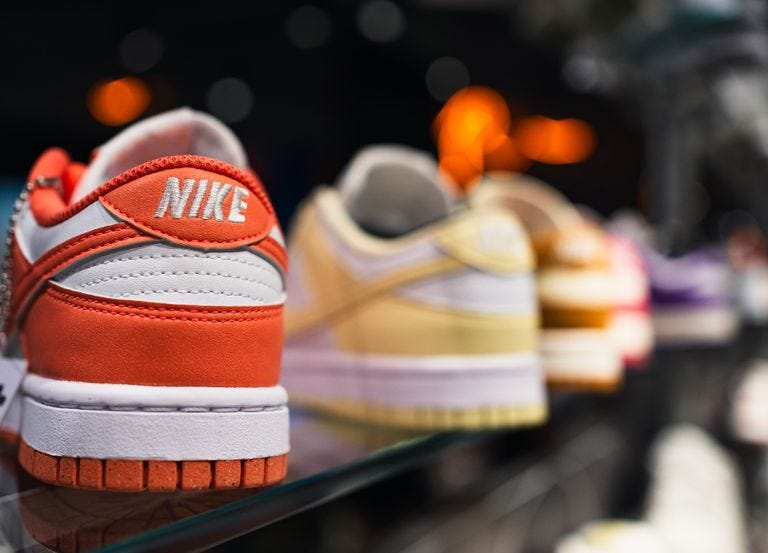
Nike's fame stems from:
Cultural impact: The "Just Do It" slogan (introduced in 1988) and empowering campaigns featuring icons like Serena Williams, LeBron James, and Colin Kaepernick
Sports dominance: Equipping 95% of NBA players and sponsoring elite athletes across every major sport
Financial performance: Reporting $54 billion in FY2025 revenue (+12% YoY growth) despite market challenges
The company faces headwinds from:
Rising competition from niche brands (On Running, Hoka)
Slowing sales in China
Inventory management issues
Yet Nike's strategic pivot to direct-to-consumer sales (40% of revenue via SNKRS app/Nike.com) and sustainability initiatives (75% recycled materials in Air soles) position it for long-term dominance. As a Dow Jones Industrial Average component, Nike remains a blue-chip favorite, with BlackRock (7.3%) among its largest institutional shareholders.
History of the Company
Nike’s journey began in 1964, when University of Oregon track athlete Phil Knight and his coach Bill Bowerman founded Blue Ribbon Sports (BRS) as a U.S. distributor for the Japanese brand Onitsuka Tiger (now ASICS). Initially, Knight sold shoes out of the trunk of his car at track meets.
In 1971, the company rebranded as Nike, named after the Greek goddess of victory. That same year, they introduced the now-iconic Swoosh logo, designed by a local Portland student for just $35. A year later, Nike made headlines with the "waffle sole", invented by Bowerman using his wife's waffle iron—a breakthrough in traction technology that helped revolutionize running shoes.
Nike went public in 1980 under the ticker NKE, marking the start of its transformation into a global powerhouse. A major turning point came in 1984 with the signing of Michael Jordan and the launch of Air Jordan—a franchise that still contributes about 10% of Nike’s annual revenue. The company’s iconic “Just Do It” campaign debuted in 1988, helping cement its image in mainstream culture.
During the 1990s, Nike expanded aggressively into international markets and other sports, notably soccer (sponsoring Brazil’s national team) and golf (signing Tiger Woods). The company also faced backlash over labor practices, but responded with a shift toward sustainability, transparency, and innovation, introducing technologies like:
Nike Air (1987)
Flyknit (2012)
Adapt self-lacing shoes (2016)
In 2003, Nike acquired Converse, strengthening its casual/lifestyle segment, while divesting non-core brands like Bauer Hockey to stay focused on athletic performance and innovation.
A Proven Dividend Eagle 🦅
Nike has evolved into a blue-chip dividend aristocrat, boasting 22 consecutive years of dividend growth since initiating payouts in 1984. The sportswear giant currently offers a 1.3% yield (as of July 2024) with a conservative 35% payout ratio, leaving ample room for future hikes. What makes Nike's dividend special:
Steady growth: Annual dividend increased 11% CAGR over past decade, outpacing inflation
Fortress balance sheet: $10B+ cash reserves support payouts even during downturns
Shareholder focus: Combined $50B returned via dividends/buybacks since 2012
While the yield appears modest, Nike's dividend durability shines through crises - maintaining payments during both the 2008 recession and COVID pandemic. The company's capital return philosophy aligns with its elite-athlete ethos: disciplined fundamentals (AA- credit rating) paired with aggressive growth (7% annual dividend hikes projected through 2026).
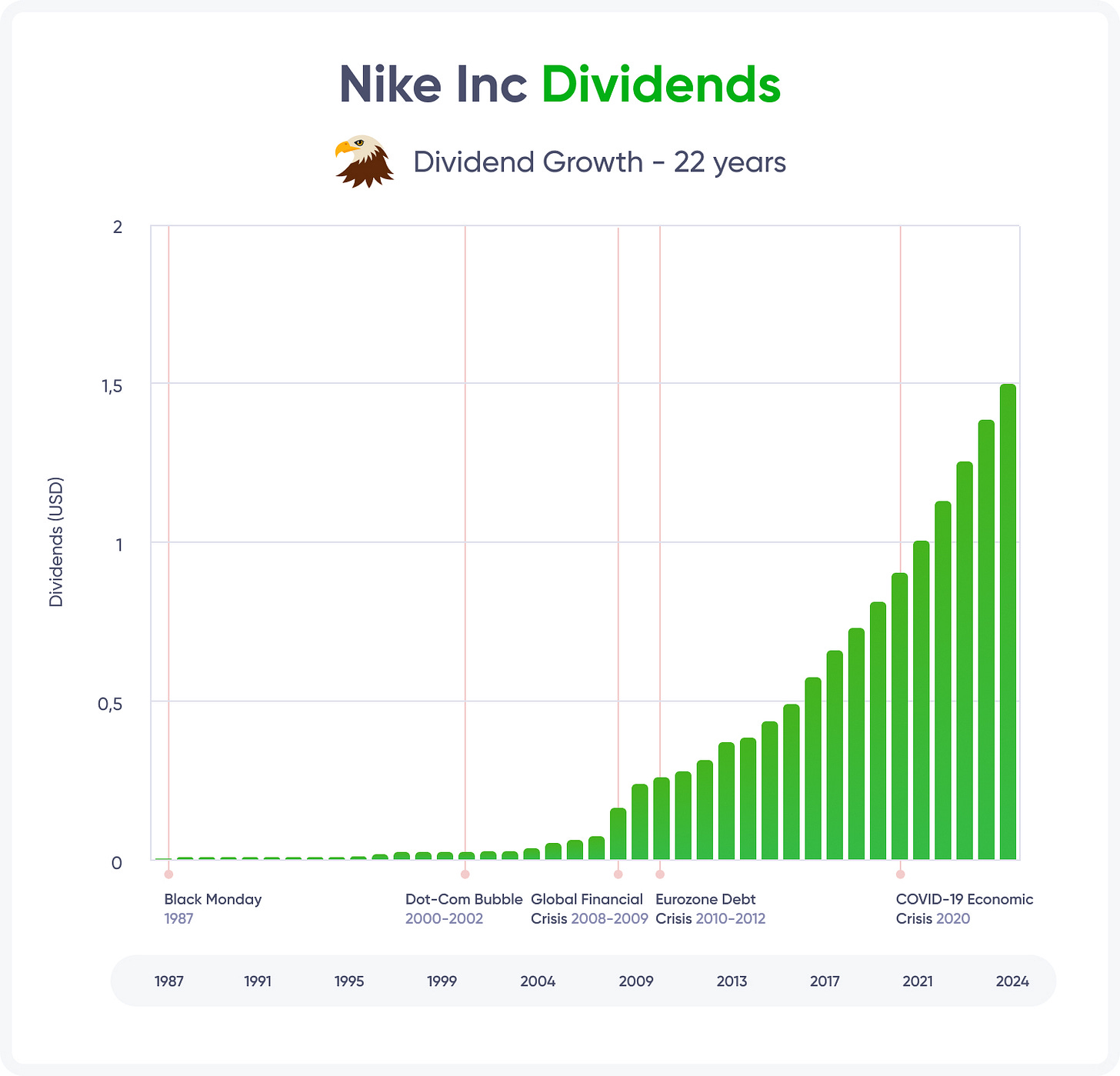
Financial Statement
Here is a quick dive into Nike over 3 last years

MaxDividends App: NikeFinancial Statement. Revenue.
Future Growth Prospects for Nike
Nike faces both challenges and opportunities in its growth trajectory. Despite recent headwinds—including a 34% decline in market cap in 2025 and softer sales in China—the company’s long-term prospects remain anchored in digital transformation, direct-to-consumer (DTC) expansion, and brand innovation.
DTC & Digital Dominance: Nike’s focus on its SNKRS app and e-commerce (now 40% of revenue) is paying off, with higher margins and deeper customer engagement. Analysts project this segment will drive mid-single-digit sales growth annually through 2026.
Product Innovation: The company continues to invest in performance technologies (e.g., Air cushioning, Flyknit) and sustainability (e.g., Space Hippie recycled line), which resonate with younger consumers.
China Rebound: While Nike’s China sales dipped in 2024–2025, its brand loyalty and partnerships (e.g., with local athletes) position it for recovery as consumer sentiment improves.
Margin Expansion: Cost-cutting initiatives and price hikes could boost operating margins to 12%+ by 2027, per analyst estimates.
Dividend Stability: With 22 consecutive years of dividend growth and a low payout ratio (~35%), Nike remains attractive to income investors, even as it prioritizes reinvestment.
Risks include competition from On Running and Hoka, inventory overhangs, and macroeconomic volatility. However, Nike’s brand strength (30% global athletic footwear share) and cultural relevance (e.g., Air Force 1’s enduring popularity) provide a resilient foundation. Analysts’ 12-month price targets average $104 (66% upside), reflecting optimism about a turnaround.
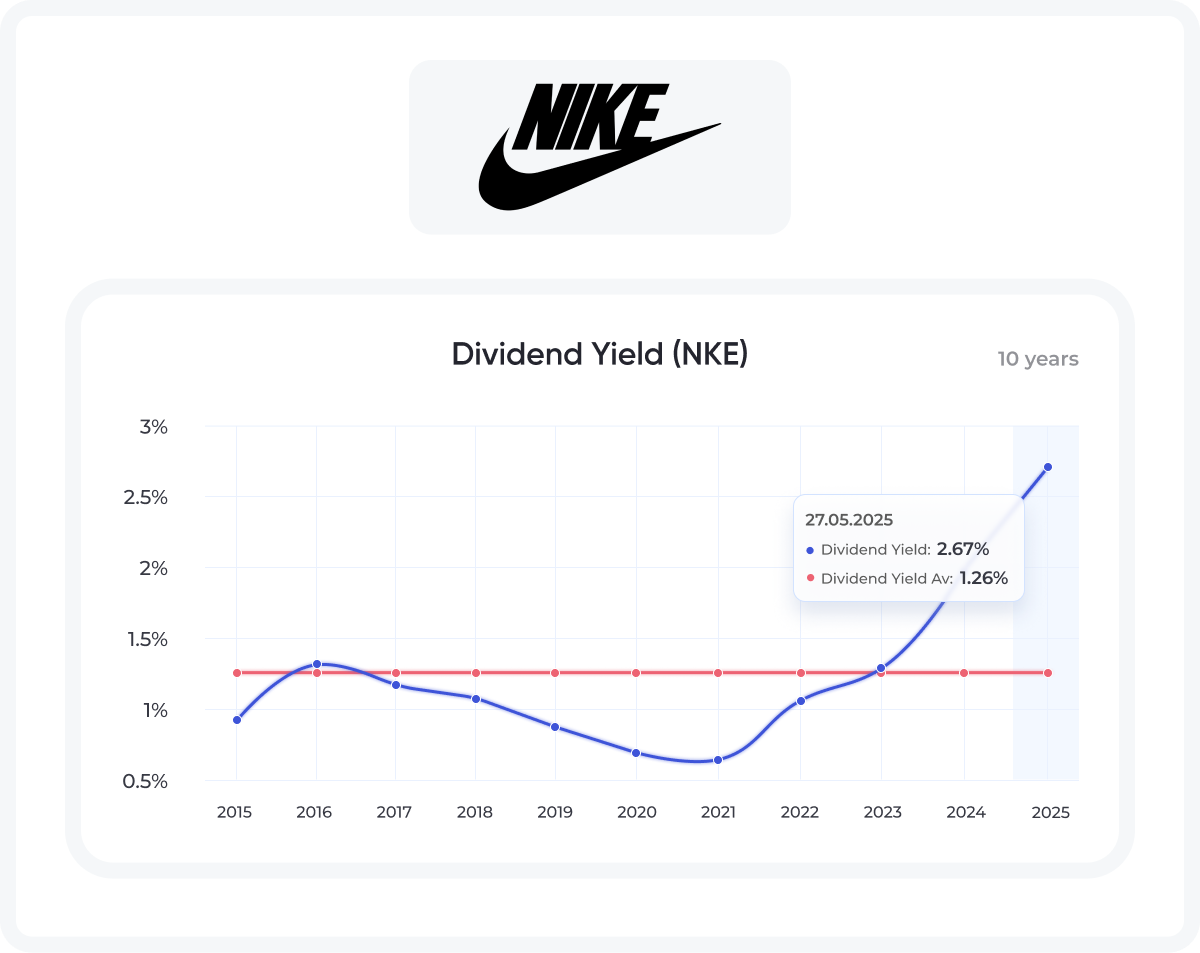
Current Dividend Yield 2.67% higher than 10 Years Average 1.26% Dividend Yield

Current Payout Ratio 51.82% higher than average 10 Years Payout Ratio 42.01%

Final Thoughts
Both Restaurant Brands International (QSR) and Nike (NKE) offer compelling investment cases, though they cater to slightly different investor profiles.
QSR is a cash-flow powerhouse with a high dividend yield (~3.6%) and a predictable franchise-driven business model. Its aggressive expansion plans (40,000 restaurants by 2028) and brand revitalization efforts (Burger King’s turnaround, Popeyes’ global growth) make it an attractive pick for income-focused investors who want steady payouts with moderate growth potential.
NKE, while facing near-term challenges (China slowdown, competition), remains a brand titan with pricing power, innovation leadership, and a growing direct-to-consumer business. Its track record of dividend growth (22+ years) and strong balance sheet make it a buy-and-hold staple for those betting on a rebound.
Which one should you choose?
If you prioritize high yield and stability, QSR is the better pick.
If you believe in long-term brand resilience and dividend growth, NKE offers more upside.
Both stocks are trading below their historical valuations, presenting a potential buying opportunity for patient investors. Diversified portfolios could even consider both—balancing QSR’s income with NKE’s growth prospects.
Bottom Line
While neither stock is without risks, their strong fundamentals, competitive advantages, and shareholder-friendly policies make them worthy additions to a long-term investment strategy. 🚀
To your wealth, MaxDividends Team
***
With MaxDividends Community you’ll always be part of a winning team and stop viewing the future as an uncertainty. Worry will fade, replaced by confidence and peace of mind. You’ll focus on doing what you love while your passive income continues to grow.
With respect for your well-being, Max
Ready to Give It a Try?
Check Your Subsription Status & Upgrade to Premium.
If you have any questions, feel free to email me at: [email protected]
⭐️⭐️⭐️⭐️⭐️
MaxDividends is a Bestseller on Substack!
Hundreds of premium members have already discovered the benefits of the community and app, earning passive income through dividends with MaxDividends. Their passive income keeps growing!
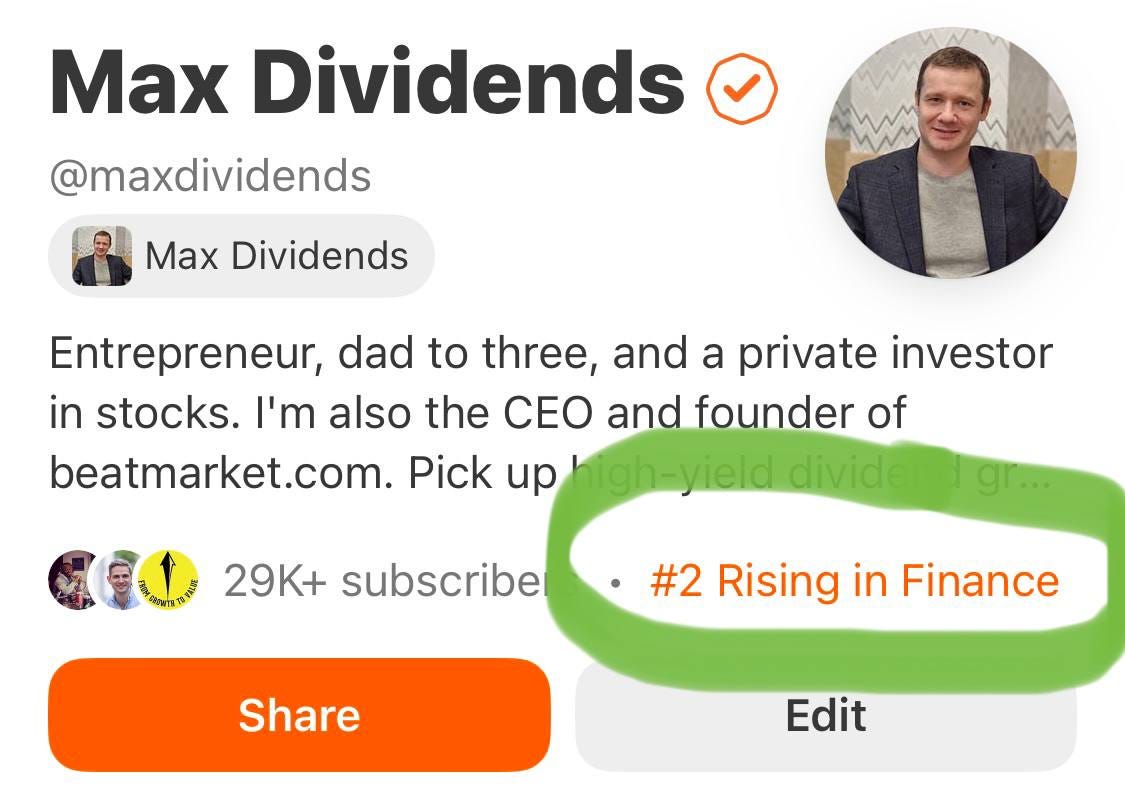
MaxDividends Community: What ELSE You’ll Get Here
+ Access to full list of Top Dividend Stocks updated weekly. Boost your passive income for living off dividends.
Unlock Top-notch dividend growth investment ideas and insights, handpicked to help you crush your financial goals, retire early and live off dividends.
Ready-to-go step by step weekly guide to achieving financial freedom.
Grab ready-made MaxDividends stock sets starting at $300, $500, or $1000 each week.
My personal MaxDividends portfolios and short list with all the changes and updates weekly.
Comprehensive tools to help you on the way retire early and live off dividends.
Community Like-Minded Access
Stay in touch with me and other MaxDividends followers. MaxDividends community chat of like-minded who wants to live off dividends and retire early. Discuss ideas, share insights, build plans and set goals. Support, motivation, like-minded - all in!
My personal life & business column where I share life moments, insights on stock investing, long-term investment philosophy, and intriguing thoughts to benefit you.
🟢 What ELSE You’ll Get
Top Dividend Ideas
Unlock exclusive, high-quality dividend investment ideas available only for Premium members. These ideas are carefully curated to maximize returns, provide growing income, and accelerate your journey to financial freedom and early retirement.
By upgrading to Premium, you’ll gain access to:
Advanced stock recommendations tailored for dividend growth
In-depth research on high-yield dividend stocks with strong growth potential
Exclusive updates and insider insights to stay ahead of the curve
Undervalued Dividend Lists
With Premium access, you’ll get:
Undervalued Dividend Eagles (updated monthly)
Undervalued Dividend Kings (updated monthly)
Undervalued Dividend Aristocrats (updated monthly)
These lists highlight the most promising undervalued dividend stocks with strong growth potential, helping you maximize returns on your investment.
Dividend Insights
Gain exclusive insights:
Top 5 MaxDividends Ideas of the Month
Top 3 Most Promising Dividend Ideas of the Week
List of Dangerous Dividend Stocks (updated monthly) – avoid risky picks
These carefully researched ideas will guide you in making smart, informed decisions to build wealth with dividends.
🟢 And even MORE!
Unlock the best dividend tools available, created by the MaxDividends Team:
Dividend Screener: Find your own hidden gems—uncover undervalued dividend stocks with high growth potential.
Dividend Portfolio Tracker: Keep track of every aspect of your passive income and optimize your portfolio.
Dividend Checker: Check the financial and dividend score of 19,000+ companies worldwide to make data-driven choices.
MaxDividends Premium gives you all the tools you need to build, track, and grow your passive dividend income to retire early and live off dividends.
We are Recommended on Substack
Trusted by 43,000+ subscribers. Followed by 37,500+ dedicated readers
The European Value Investor ⭐️⭐️⭐️⭐️⭐️
“If you are interested in dividend strategies or passive income strategies, this Substack ia great! Its worth a visit“
Johan Lunau - The Long View ⭐️⭐️⭐️⭐️⭐️
“Practical dividend focus. Saving for retirement.“
Shailesh Kumar - The Astute Investor’s Calculus ⭐️⭐️⭐️⭐️⭐️
“Love the concept and the execution. If you are into building a portfolio that will generate ever growing income for you, subscribe to Max Dividends. I did.“
MS Cliff Notes ⭐️⭐️⭐️⭐️⭐️
“A useful substack for those that invest in stocks that pay dividends or are looking to get into such a strategy. Includes education and actionable ideas.“
Timothy Assi - Panic Drop ⭐️⭐️⭐️⭐️⭐️
“Great for helling you pick up high-yield dividend growth stocks“
And 220+ more other great authors and pro’s are recommend MaxDividends!
MaxDividends Mission
Helping & Supporting Everyone in Building a Growing Passive Income, Retiring Early, and Living Off Dividends.
FAQ
Someone's sitting in the shade today because someone planted a tree a long time ago. ― Warren Buffett.